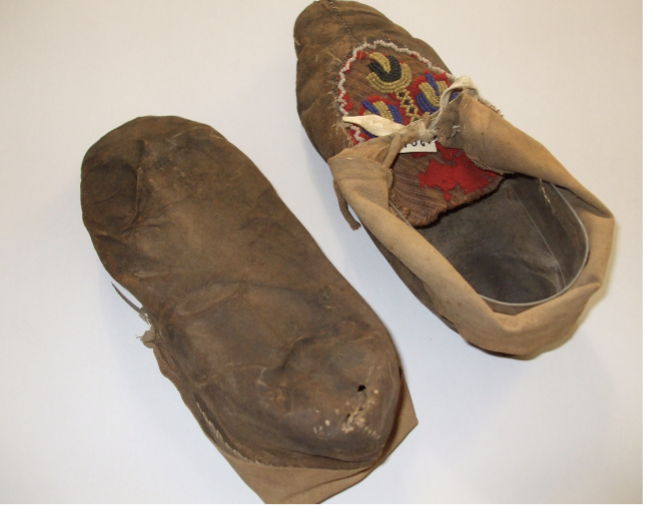From Giuliana Taccone
Where did you come from? Who were you made by? How did you get to Italy?
These were questions that I first asked myself when I came across pairs of moccasins listed on the GRASAC platform. There are three pairs of moccasins located in the Museum of Anthropology and Ethnology in Florence, Italy attributed to the “Kingsmith Mavies” donation. These moccasins are geographically disconnected from their source community, and at the same time, there was a disconnect in their recorded history.
The GRASAC record indicated uncertainty regarding the moccasin’s provenance history. On the entry pertaining to the beaded moccasins, a note stated that the moccasins were from the Prairies, and a later note clarified that they came from the Great Lakes. When I reached out to the holding institution, they notified me that a recent study based on visual analysis had attributed them to the Iroquois.
Significantly, through this communication, I learned that the listed donor’s name, “Mrs. Kingsmith Mavies” was a transcription error and that the correct name was Mrs. Laura Norcross Marrs. This was critical information. Following this lead, I explored the connection with Mrs. Marrs’ sister-in-law Evangeline Whipple (née Marrs) and her husband, Bishop Henry Whipple.
Henry Whipple was an Episcopal Bishop and missionary who worked in Minnesota beginning in the 1860s. He was a conflicting figure. Impacted by what he witnessed, he advocated for Indigenous rights and drew attention to injustices faced by Indigenous communities. However, as a missionary, his work was deeply rooted in a colonial mindset, and he actively supported the Christianization of Indigenous peoples. He was involved in missionary work in a few reservations including White Earth, Red Lake, Leech Lake, Birch Coulee and Faribault.
Bishop Whipple and his wife Evangeline held close friendships with Ojibwe and Dakota people in Minnesota. They received various gifts and, over time, acquired a large collection of Indigenous made items. For example, because of his advocacy and support in the Leech Lake timber controversy, Bishop Whipple was gifted a beaded stole made by the wife of Chief Flatmouth. Evangeline was also gifted moccasins. There are examples by Sarah Good Thunder (Dakota) and miniature moccasins by Julia Walker Lawrence (Dakota) that are held by the Minnesota Historical Society.
The style of the moccasins held in Florence resembles those that Evangeline was gifted. More generally, they share similar attributes to moccasins made in the region where Evangeline and Bishop Whipple lived and worked. According to studies by David Sager, the center-seam and vamp pattern are commonly associated with the Ojibwe, however in this region, it was also being made by the Dakota as early as the 1830’s. Furthermore, the moccasins that are decorated with ribbon applique share strong similarities with the moccasins in the Minnesota Historical Society collection which also feature ribbon applique. These moccasins also come from the Whipple collection.

Bishop Whipple passed away in 1901; nine years later Evangeline moved from Minnesota to her brother Kingsmill Marrs’ villa in Florence, likely bringing part of the Whipple collection with her. The moccasins would eventually be donated to the museum by Laura Norcross Marrs, Kingsmill’s wife, in 1925.
Provenance research and visual analysis strongly indicate that the moccasins come from a Dakota or Ojibwe maker in Bishop Whipple and Evangeline’s circle in Minnesota. They were likely collected anytime between 1860 (when Bishop Whipple’s missionary work began in the area) and 1910 (when Evangeline moved to Florence).
The GRASAC record will soon be updated to indicate these new learnings, but there is still more work to be done. Further research may be able to connect these moccasins to their makers, or to gain insights on their beadwork and repairs. If you have any additional information that could support this research, you are welcome to reach out to me at Giuliana.taccone@gmail.com and to GRASAC at grasac.pm@utoronto.ca.
Further Reading
National First Ladies Library, “Legacy Lecture: Faithfully Yours, Lives of Rose Cleveland and Evangeline Simpson Whipple.” Published January 5, 2023, YouTube Video, https://www.youtube.com/watch?v=xNzCF-mgVv4
Lincoln, Louise and Paulette Fairbanks Molin, “Unanswered Questions: Native Americans and Euro-Americans in Minnesota,” in Art and Life on the Upper Mississippi 1890 – 1915, edited by Michael Conforti, 299 – 333. Newark: University of Delaware Press, 1994.
Zavattaro, Monica. “Kingsmill Marrs Donation,” in The Museum of Natural History of the University of Florence Volume V – The Anthropological and Ethnological Collections, edited by Jacopo Moggi Cecchi and Roscoe Stanyon, 142 – 144. Firenze University Press, 2022.
Sager, David. “Ojibwa Moccasins: Center Seam/Vamp.” Whispering Winds 36, no. 6 (May 2007).
Sager, David. ”Dakota Center Seam/Vamp Moccasins.” Whispering Winds 47. No 4 (Fall 2019).
Fouquerel- Skoe, Louise, Terru Kreps and Elizabeth Routzahn,”Bishop Whipple: Decolonizing and Indigenizing Concordia,” Cordopedia.
Giuliana Taccone (she/her) is a passionate student of arts and cultural heritage and a recent graduate of the Master of Museum Studies program at the University of Toronto. She is committed to fostering meaningful connections between communities and cultural institutions and aspires to work in public programs and museum education.


